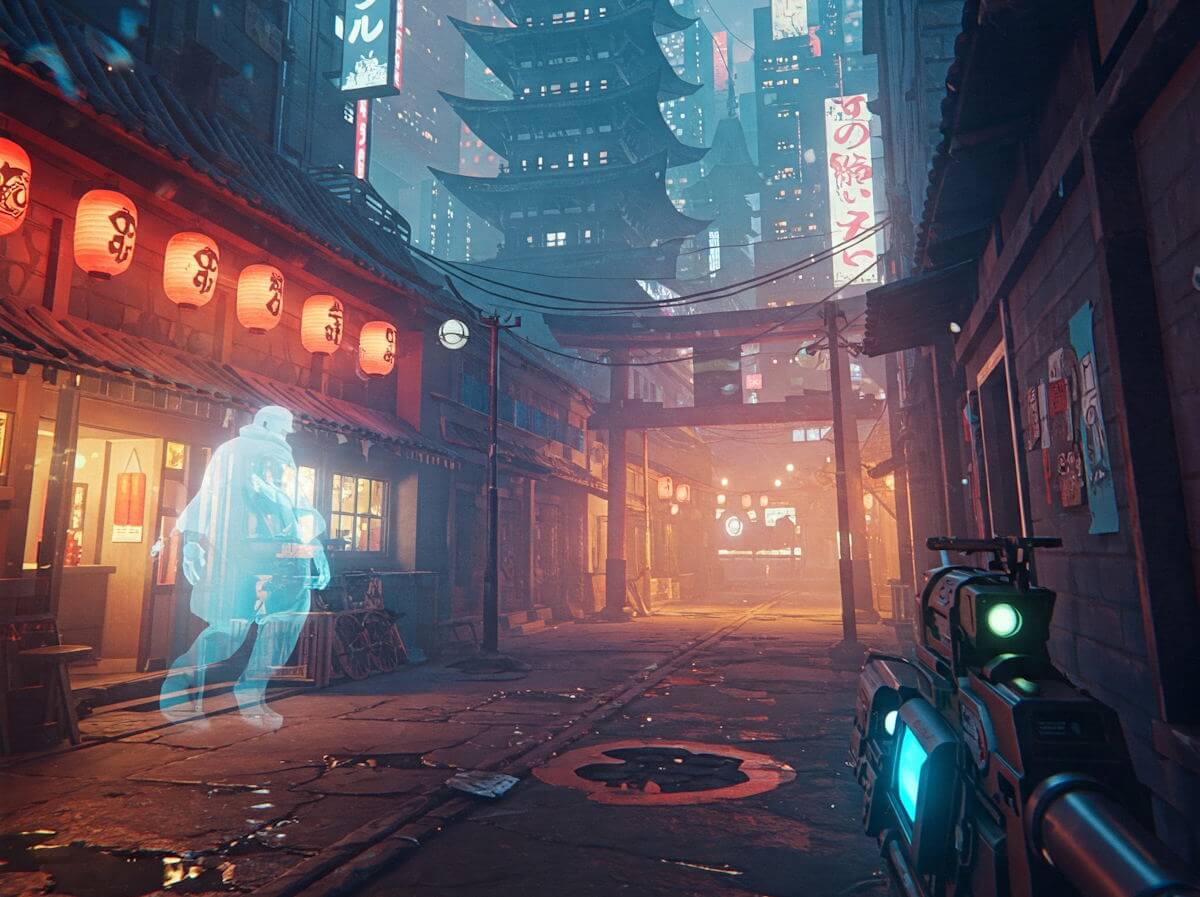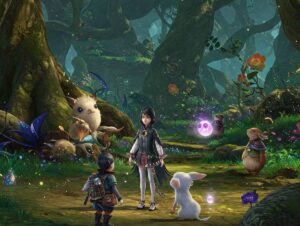Ghostwire: Tokyo is a video game that emerged from the creative minds at Tango Gameworks, a studio known for its atmospheric and stylistic storytelling. Developed under the direction of Shinji Mikami, the pioneer behind the Resident Evil franchise, Ghostwire: Tokyo embodies a significant departure from traditional horror elements, weaving an intricate narrative that is steeped in Japanese folklore and supernatural occurrences. Released in March 2022, the game invites players to explore a stunningly rendered version of Tokyo, which has been transformed into a ghost-infested realm following a mysterious event that has caused most of the city’s population to vanish.
The game’s narrative revolves around the protagonist, Akito, who finds himself in a haunted version of Tokyo, filled with malevolent spirits known as “Visitors.” Tasked with uncovering the mystery behind these apparitions and the disappearance of the city’s inhabitants, players navigate through the haunting streets, where they encounter emblematic locations such as Shibuya and Asakusa, each replete with its own eerie ambiance. The rich lore and engaging story provide a captivating backdrop, allowing players to engage deeply with the haunting world around them.
Graphically, Ghostwire: Tokyo stands out with its blend of realism and stylistic features, showcasing the bustling yet eerie Tokyo landscape. The environmental design captures the essence of the city while instilling an unsettling atmosphere, enhanced by an evocative soundtrack that complements the ghostly themes. The game utilizes advanced technologies to achieve breathtaking visual fidelity, placing players directly into an immersive experience that blurs the lines between fantasy and horror. With its unique premise and striking presentation, Ghostwire: Tokyo offers a distinctive adventure for both action and horror enthusiasts, inviting them to unravel the mysteries of a city overrun by spirits.
Visual Appeal and Artistic Design
Ghostwire: Tokyo captivates players with its striking visuals and artistic design, merging the essence of traditional Japanese culture with modern aesthetics in a uniquely compelling manner. The character design showcases a variety of distinct figures, each meticulously crafted with attention to detail, from their clothing to their facial expressions. These elements not only bring each character to life but also enhance their narrative significance within the game’s immersive experience.
The environment art of Ghostwire: Tokyo is equally impressive, presenting a reimagined version of Tokyo teeming with supernatural elements. Players can explore a hauntingly beautiful rendition of the city, characterized by a blend of familiar landmarks and eerie, otherworldly phenomena. This juxtaposition creates an unsettling yet fascinating atmosphere, drawing players deeper into the game. The developers have crafted environments that feel alive, incorporating realistic lighting and intricate textures that elevate the overall aesthetic appeal.
Performance across various platforms plays a crucial role in delivering this visual experience. On next-generation consoles and PCs, Ghostwire: Tokyo showcases enhanced graphical fidelity, with higher resolutions and frame rates that allow for fluid gameplay and richer detail. Meanwhile, even on older hardware, the game manages to maintain a commendable quality, ensuring that players do not compromise the artistic design for performance. This versatility allows a broader audience to appreciate the stunning visuals, irrespective of their gaming system.
The art style of Ghostwire: Tokyo not only serves as a visual feast but also contributes significantly to the game’s overall mood, embodying the eerie yet enchanting atmosphere that encapsulates the essence of a supernatural Tokyo. By skillfully blending traditional and modern elements, the game offers a rich visual narrative that sets the stage for an unforgettable gaming experience.
Gameplay Mechanics and Combat Systems
Ghostwire: Tokyo showcases a distinctive blend of gameplay mechanics that focus on exploration, puzzles, and combat systems. This amalgamation provides players with a somewhat immersive experience in a beautifully crafted rendition of Tokyo. The exploration aspect is primarily driven by the protagonist’s supernatural abilities, which allow for unique traversal options throughout the game’s open world. Players can move fluidly between rooftops, using a parkour-style movement system that encourages dynamic interactions with the environment.
The combat system in Ghostwire: Tokyo is both innovative and accessible, featuring a unique arsenal of supernatural powers that serve as the primary means of engaging enemies. Players wield elemental abilities such as wind, water, and fire to combat the various spectral foes that inhabit Tokyo’s streets. These powers not only vary in elemental strengths but also possess unique attributes that encourage diverse combat tactics. For example, players can harness wind to push back enemies and create distance or use fire to deal area-of-effect damage in tighter encounters.
Puzzles further enrich the gameplay mechanics, introducing challenges that require players to utilize their abilities creatively. These puzzles often revolve around uncovering hidden items or navigating through spectral barriers, thus reinforcing the game’s thematic elements. However, while these mechanics can be engaging, they may also be perceived as simplistic by seasoned gamers, leading to questions about the depth of the overall experience.
In summary, the gameplay mechanics and combat systems in Ghostwire: Tokyo provide a stylish yet somewhat shallow experience. While the unique abilities of the protagonist facilitate engaging exploration and imaginative combat, they may lack the necessary complexity to sustain long-term interest. This balance between innovation and simplicity impacts the overall enjoyment of the game.
Narrative and Character Development
‘Ghostwire: Tokyo’ presents a narrative that intertwines the supernatural with traditional Japanese folklore, positioning players in a hauntingly beautiful Tokyo overrun by mysterious entities. The storyline follows protagonist Akito, who wakes up amidst chaos and discovers that his city is plagued by supernatural beings. As the narrative unfolds, players delve into Akito’s motivations, which revolve around rescuing his sister, who is pivotal to his journey. This personal quest serves as a central theme, motivating Akito to confront the ghostly inhabitants of the city.
Character development in ‘Ghostwire: Tokyo’ is intricately linked to the pacing of the game. The primary antagonist, Hannya, embodies the game’s thematic exploration, representing the unseen terrors in society. His backstory, much like Akito’s, is revealed progressively, creating a contrast that deepens the player’s understanding of both characters. However, while the motivations of Akito are clearly articulated, other characters often lack the same depth, leaving some relationships feeling either underexplored or cliched. This inconsistency can detract from the emotional engagement players seek, as character arcs seem to oscillate between compelling narratives and superficial interactions.
The pacing of the story is another significant factor that influences player engagement. While the initial segments are riveting and filled with discovery, the later parts of the game can feel rushed. This could lead to sentiment that the overall weight of the narrative is sacrificed in favor of action. Consequently, the emotional resonance intended by the developers can feel diluted. Moreover, the limited exploration of secondary character backgrounds can be frustrating for players looking for a richer, more nuanced storytelling experience.
In conclusion, ‘Ghostwire: Tokyo’s narrative and character development offers a blend of engaging themes and emotional motives, yet it does not fully realize its potential. A more in-depth exploration of character relationships and a more consistent pacing could elevate the overall storytelling experience, enhancing player immersion and connection to the haunting world of Tokyo.
Exploration of Tokyo: The Open World Experience
Ghostwire: Tokyo presents players with a captivating open-world environment that mirrors the vibrant streets and neighborhoods of its real-world counterpart. The game allows players to traverse a reimagined Tokyo, where the density of content is both impressive and immersive. Various areas of the city feature unique atmospheres, from the bustling streets of Shibuya to the eerie tranquility of deserted alleyways, contributing to an exploration experience that feels rich in detail.
As players navigate the diverse neighborhoods, they encounter numerous activities that highlight the cultural aspects and history of Tokyo. The integration of local landmarks and urban myths fosters a feeling of authenticity that enhances the player’s engagement. While the environment may seem inviting, the interactivity within the open world has been critiqued for lacking depth; many activities offered in the neighborhoods can feel repetitive, potentially detracting from the overall exploration experience. However, the aesthetic quality of the game undeniably captivates the players, serving as a picturesque backdrop for their adventures.
The fast travel system allows for efficient navigation across the expansive layout, providing players with a convenient means to jump between key locations. While this aspect facilitates exploration, it can also diminish the sense of discovery, as players may opt to fast travel rather than explore the untamed facets of the city. The map system is well-designed, offering clear markers and attractions that guide players, though some may find the initial learning curve steep. Despite some common criticisms regarding content variety, Ghostwire: Tokyo establishes an alluring world that encourages exploration, allowing players to immerse themselves in an enthralling rendition of one of Japan’s most iconic cities.
Soundtrack and Sound Design
The audio experience of Ghostwire: Tokyo plays a pivotal role in shaping its overall atmosphere, intertwining seamlessly with its visual and gameplay elements. This integration is evident in the game’s diverse soundtrack, which features a mixture of traditional Japanese music and modern compositions, creating a unique auditory experience that complements the game’s setting. The score is crafted to evoke emotions that correspond with the narrative, allowing players to feel a deep connection to the storyline. Tracks often swell during critical moments, amplifying tension and excitement, while softer melodies provide a reflective backdrop during exploration.
In addition to the soundtrack, the ambient sounds throughout Ghostwire: Tokyo greatly enhance immersion. The game is set in a deserted Tokyo, and the haunting echoes of urban life that linger in the air contribute significantly to the atmosphere. Whether it is the distant sounds of the wind whistling through empty streets or the eerie silence of abandoned buildings, these elements serve to evoke a sense of unease that is central to the game’s thematic core. Furthermore, subtle audio cues alert players to supernatural threats, integrating gameplay mechanics with sound design in a manner that feels organic and intuitive.
Voice acting also merits attention, as it is a critical aspect that adds depth to character interactions. The performances are generally well-executed, delivering emotional weight and personality that enhance the narrative. Dynamic voice lines not only help in conveying character development but also aid in immersing the player within the rich lore that Ghostwire: Tokyo presents. Overall, the game’s sound design, including its evocative soundtrack, attentive ambient sounds, and solid voice acting, manages to elevate the experience, creating an engaging audio landscape that supports the visual storytelling and gameplay while providing essential cues for players navigating this mystical Tokyo.
Critical Reception and Player Feedback
‘Ghostwire: Tokyo’ has generated a wide array of responses from both critics and players since its release, creating a discourse marked by contrasting opinions. Critics have generally praised the game’s captivating aesthetics and atmospheric world design. The visual presentation, heavily influenced by Japanese folklore and urban landscapes, has been described as stunning and immersive, effectively drawing players into a hauntingly beautiful version of Tokyo. The unique art style and engaging character designs contribute significantly to the game’s allure and have received commendations for their originality.
However, despite its visual appeal, many reviewers have pointed out that the gameplay mechanics lack depth. The combat system has faced criticism for becoming repetitive over time, with players noting a reliance on a limited set of abilities that do not evolve substantially throughout the game. This sameness in gameplay experience has left some players craving more varied and engaging interactions with the game’s environment and enemies. Similarly, the narrative, while intriguing, has been seen by some as underdeveloped, leading to a sense of disconnection from character motivations and overall objectives.
Player feedback emphasizes these observations as well. Many players express admiration for the game’s aesthetics but share concerns regarding the gameplay loop’s monotony. However, the community has also highlighted some enjoyable aspects, such as the sense of exploration and discovery within Tokyo and encounters with ghostly entities, yet these elements have not fully offset any gameplay limitations.
In conclusion, ‘Ghostwire: Tokyo’ represents a dichotomy within the gaming experience. The stylish presentation and exploration aspects stand out, but the shallow gameplay mechanics reduce its overall impact. As such, both critics and players agree that while the aesthetic experience is commendable, the lack of depth in gameplay remains a significant drawback for many. The consensus suggests that ‘Ghostwire: Tokyo’ is a feast for the eyes, but the gameplay may leave some players wanting more.
Comparative Analysis with Other Games
In the ever-evolving landscape of action-adventure and horror games, titles such as Ghostwire: Tokyo have drawn considerable comparisons with peers, particularly focusing on gameplay design and thematic elements. When examining its mechanics and narrative style, one can draw parallels with prestigious games like Resident Evil Village and the acclaimed Silent Hill series. While each of these titles offers unique experiences, they share fundamental gameplay structures that influence player immersion and engagement.
Resident Evil Village, for instance, blends psychological horror with survival mechanics, ensuring tension permeates throughout the gameplay. The game’s depth lies in intricate puzzles and a well-developed storyline that keeps players invested. Conversely, Ghostwire: Tokyo prioritizes an open-world exploration that, while visually captivating, lacks the same level of rich narrative intricacies. The absence of substantial character development in Ghostwire: Tokyo is noticeable compared to its counterparts, as the story relies heavily on environmental storytelling rather than deep character arcs.
Another point of contrast can be found with Fatal Frame, which implements a unique gameplay mechanic based on the use of a camera to capture and combat spirits. This innovation not only enriches the gameplay but adds a layer of horror through strategic mechanics. Yet, Ghostwire: Tokyo sticks to a more conventional combat system centered around elemental powers, which, while visually impressive, struggles to maintain long-term player engagement. Such mechanistic choices result in a gameplay experience that can feel repetitive over time.
Additionally, while Ghostwire: Tokyo excels in atmospheric design, the gameplay depth often appears overshadowed by the stunning visuals. The reluctance to integrate more compelling gameplay elements, as seen in games like Outlast and its dedicated pacing and tension building, impacts how players connect with the experience. Ultimately, while Ghostwire: Tokyo is stylistically appealing, it may not resonate with those seeking substantial gameplay depth found in its contemporaries.
Conclusion: The Balance of Style and Substance
In reviewing the various elements of ‘Ghostwire: Tokyo’, it becomes apparent that the game is a testament to atmospheric design and aesthetic innovation. From the vibrant recreation of Tokyo’s neon-lit streets to the intricate representations of Japanese folklore, the visual aspects undoubtedly stand out. Players are transported into a digitally rendered world that feels both immersive and captivating. However, despite the impressive stylistic choices, the gameplay experiences leave much to be desired. The mechanics often feel repetitive and lack the depth that many players expect from modern action-adventure titles.
The emphasis on style raises questions about whether ‘Ghostwire: Tokyo’ effectively balances its visual allure with substantive gameplay. Players may find themselves enamored by the stunning landscapes and creatively designed spirit foes, yet the absence of a robust, engaging narrative and varied combat systems can diminish the gaming experience. Moments of excitement arise, but they can be overshadowed by a sense of monotony that creeps in as the journey unfolds.
As we reflect on the game’s legacy, it is essential to consider its potential influence on future titles within the genre. While ‘Ghostwire: Tokyo’ may falter in gameplay depth, it serves as an important case study in marrying style and substance in video games. Developers may take cues from its artistic bravado while keeping an eye on the necessary engagement and interactivity that players seek. The delicate balance struck here will undoubtedly inform forthcoming games, raising the bar for how artistic vision can be harmonized with gameplay mechanics. In summary, while the game offers a visual spectacle, its shallow mechanics may hinder its overall impact within the gaming community.




